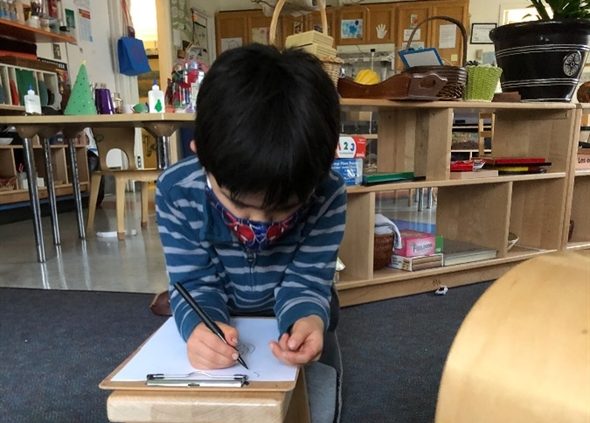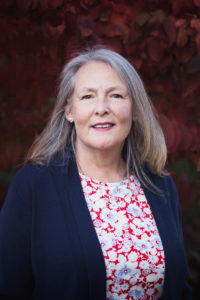When COVID-19 restrictions moved learning online for all K-12 and college students in the state in March 2020, Clark’s Child and Family Studies (CFS) kept its doors open to fill a vital role of providing childcare to families of essential workers and Clark students, as well as providing jobs for Clark students.
Clark 24/7 interviewed CFS Director Michele Volk to find out how her team has been safely serving families during the pandemic. “It’s been a journey,” she said. “We’ve received such positive feedback from our student families about the difference it makes having a community there for their children. … By caring for the children of Clark students, CFS is equipping our students to do their own schoolwork and be successful.”
Throughout the months of pandemic lockdown, CFS remained open—and welcomed school-age learners, too. It’s been a learning process for all involved, as the edited interview below proves.
Q: Did CFS operate during spring term when pandemic restrictions first were enacted?
MV: Yes. Throughout the pandemic we remained open for essential workers as defined by Washington State. We erred on the side of caution as guidance changed frequently.
Q: How has CFS adapted to continue operating during COVID restrictions?
MV: CFS has adapted to COVID by continual monitoring of the recommendations, guidance and mandates of licensing, Washington Department of Health, CDC, Clark County, and Clark College. We are following safety protocols and best practices. Here are some of ways we adapted:
- Added a school-age classroom fall term to accommodate Clark students whose children were at home doing school remotely
- Decreased the total number of children in program
- Reduced the number of classrooms in use from six to four
- Decreased number of children in each classroom
- Altered hours to stay within stable, consistent groups because we cannot combine groups of children or staff
- Doubled the square-footage COVID social-distancing space recommendation for each environment
- Implemented drop-off and pick-up procedures: eight-foot distancing between families, mask wearing, temperature taking, health screening questions, and hand washing
- Installed Plexiglass barriers, including between larger tables in the school-age classroom
- Masks: All staff wear masks within six feet of another adult; children age 5 and older wear masks in the classroom
- Increased the frequency of sanitizing commonly touched items and spaces
- Pre-COVID group projects have been adapted to individualized sensory projects
- Increased time children spend outside by extending outdoor teachers’ schedule and going on more campus walks
- Changed our typical self-service, family-style school meals to teachers serving children, using one-time serving utensils and dishware to limit our chef’s exposure

Q: How many children are attending CFS during the pandemic?
MV: Pre-pandemic during fall quarter 2019, we had 128 children enrolled at CFS. In contrast, the 2020 numbers during the pandemic are a fraction of our earlier enrollment: summer break, 41 children; summer quarter, 47; fall quarter, 71; winter quarter, 69.
Q: What have been some of the biggest challenges of operating CFS during COVID?
MV: One challenge has been battling the emotional fatigue of the staff and families. Their stress levels have been high, yet they have continued to be present for the community. It’s been difficult missing all in-person family gatherings, community meetings, and the in-person collaboration of a full program. It has been both challenging and touching to see how remote instruction has adapted for ECE lab and Family Life credit. People are finding unique ways to build relationships through Zoom, examining practices, videotaping and sharing of resources to meet outcomes. Despite the decreased enrollment and ratios, stable classroom groups and increased costs, we are committed to keeping everyone employed and engaged.
Q: What are some highlights–some uplifting, heartwarming moments at CFS during COVID?
MV: Hearing family stories has really touched my heart—knowing we have contributed to student retention and success. Having families grateful for our services so they can continue or return to work. Families have stopped by the front desk and expressed their gratitude for being able to either go to school or go to work to provide for their family during this time. Some have brought teachers and office staff flowers and treats.
Q: Are there any positive elements to the children’s experience?
MV: It was heartwarming to see children coming back after time away—to see them reunite with their peers and teachers. Seeing children run to be together. School–age children have been reunited with their peers, with whom they attended toddlers’ class or preschool.
With fewer children, it seems children are working longer on projects and working more together. The learning stories feel deeper, more connected. Teachers have more time to observe, document, and expand children’s learning. Families have been connected in these moments and connected us to home. This has become a very connected community.

Q: How has your staff stepped up to the plate throughout the pandemic?
MV: Our staff are the true heroes. Throughout the pandemic, they have been present to care for others, even as their own worlds are impacted. The way the teachers, office staff, and ECE faculty have respectfully altered their own lives, dug into deeper practice, meeting children and families where they are, the commitment and collaboration with one another and to safely keep children at the heart of their work–that’s inspiring!
Q: How have Clark’s CFS student employees made an impact during the pandemic?
MV: For many of those families, that part-time position at CFS also allows the family to have some stability financially. Those same student employees provide continuity for our children in our classroom. The sense of the routine and continuity for everyone in the community has been exceptional. I believe these children are resilient because of the model of the adults—both their family members and staff—who surround them and keep those consistent routines. These adults revel in the joy with the children. That’s made the difference.
Q: How many Clark students currently are employed at CFS?
MV: It has ranged each term between 19 and 25. We are currently hiring for several positions in both classroom and office, for those who have interest.
Q: How has the Clark community supported CFS through this challenging time?
MV: I so appreciate the larger Clark College community and their contributions to making this successful: Emergency Management Team; Facilities Services and the custodial team; Culinary and the treats for our staff and families; the Office of Diversity Equity and Inclusion’s equitable decision-making and connecting students to one another; Communications and Marketing for supporting our communications to parents; Instruction and the creativity they have shown; Student Affairs’ weekly tips and resources. So many more.
Q: Going forward, do you see some COVID precautions continuing with CFS?
MV: Yes. Post-COVID we will continue with hand-washing, increased sanitizing, and face masks will continue as long as guidance recommends. Pre-COVID we already were doing many of the recommended safety precautions, but we increased the frequency. After COVID we will continue having families wash their hands in the office before entering the program. We plan to continue the sanitizing of the office spaces and commonly touched areas. Clark’s Facilities staff have been helpful and responsive. We appreciate them.
Q: Will CFS continue its school-age children classroom after public schools open their doors to in-person learning later this month?
MV: Yes, we are working with families to make schedule changes to their CFS attendance days to meet their public school-schedule needs. We made a commitment to our children and families for the full school year. They have experienced so much change, and we are here as one of their few support systems.
Q: How do Clark students register to use CFS? Is there a waiting list? Are drop-ins welcome?
MV: We have limited spaces available. Families can check availability in their child’s age group by emailing cfs@clark.edu or calling 360-992-2393. If we have no current availability, the family will be asked if they would want to complete an interest form. We prioritize our student families when placing new families. We do not have drop-in care available but operate on stable and consistent groups for best practice in early learning.














1 comment for “Child care during COVID: An interview with Child & Family Studies Director Michele Volk”